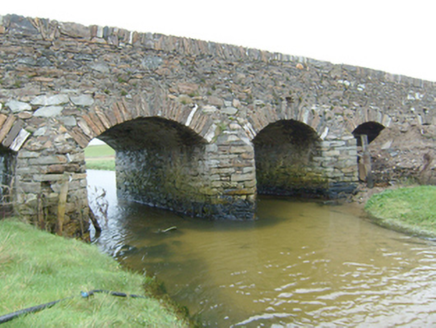Survey Data
Reg No
40807004
Rating
Regional
Categories of Special Interest
Architectural, Technical
Original Use
Bridge
In Use As
Bridge
Date
1760 - 1820
Coordinates
200937, 437382
Date Recorded
18/11/2010
Date Updated
--/--/--
Description
Twelve-arch bridge carrying road over tidal stream from New Lake to Sheephaven Bay, built c. 1760, and possibly containing earlier fabric, having squared and coursed rubble stone V-profile cutwaters to piers to both upstream (west) and downstream (east) elevations . Segmental-headed arches having squared rubble stone voussoirs; squared rubble stone construction to arch barrels. Rubble stone construction to spandrels; rubble stone construction to parapets with field stone coping over. Modern water pipe attached to the east elevation. Tarmacadam deck. Located in the rural countryside to the north-west of Dunfanaghy adjacent to where steam discharges into Sheephaven Bay.
Appraisal
A well-constructed road bridge that is of architectural and technical merit, and which forms an attractive feature, of some picturesque appeal, in the rural countryside to the north-west of Dunfanaghy and to the south end of the Horn Head Peninsula. It is well-built in local rubble stone masonry, and its continued survival and use stands as testament to the quality of its original construction, and of the skill of the masons involved. The largely unrefined rubble stone construction helps create an appealing composition while the twelve small arches with prominent cutwaters provide visual relief against its elongated form. It probably dates to the second half of the eighteenth century or to the first decades of the nineteenth century, a period when a great deal of road and bridge building was carried out by the Grand Juries in Ireland, the forerunners of the County Councils. It is probable that it has some connection with the Stewart family of nearby Horn Head House (see 40807001) a short distance to the north. This was the site of a Stewart house from c. 1700-1 (although the present house dates to the mid-eighteenth century) so it is likely that there was a bridge (or fording point) at this site from at least this date to facilitate access to this once fine country estate. The Stewarts were landlords of vast tracts of land the start of the eighteenth century until the very start of the twentieth century, and more than likely funded or largely funded the construction of this bridge. This bridge is a good example of an early multiple arch bridge, and is an integral element of the built heritage and transport history of the local area. It remains an important component in the local transport infrastructure.









